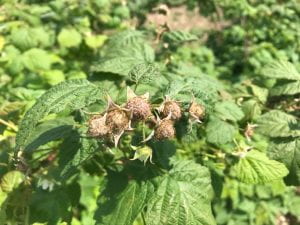Strawberries: mostly at fruit set with some late flowers still present, especially on later varieties. Starting to see ripening berries on early varieties (Wendy, Earliglow), so expect harvest to start within the next week, though cooler weather this weekend may slow things down again.

I’m glad to see lots of irrigation going on in the fields this week – adequate water is very important for fruit size and plant health. If using overhead sprinklers or jets, be sure to turn off water in time for the plants to dry off going into the evening to reduce disease development. The warm weather has also brought on pests: tarnished plant bugs, aphids, spittlebugs, thrips. The tarnished plant bugs, in particular, can be very damaging to fruit quality, causing malformed berries. Tap several flower clusters over a white paper or plastic lid to see what is in your field.

As we move to harvest, the focus switches to fruit rots (botrytis, anthracnose, leather rot) and pests of ripe fruit (SWD, slugs, sap beetles). Two-spot spider mites are a concern throughout the season, particularly under hot, dry conditions. Remember that mite thresholds are quite low – use a presence/absence method. Look at 60 fully expanded tri-foliate leaves and if you find 15 mites you have reached threshold. You may want to spray and then add beneficial predator mites as soon as possible to fields to control these pests. Potato leafhoppers may start showing up soon as well. Look for discolored/mottled leaves, especially on field edges.
Blueberries: Petal fall to small green fruit, crop loads vary by field, but generally seems to be good. As bees come out of the fields, insecticides for cranberry and cherry fruitworm, leafrollers and tip borers are appropriate. Scout for fruitworms by turning over fruit clusters (especially at field edges) and looking for small entry holes on the top and bottom of the berries. Cranberry fruitworm larvae web the berry clusters together and feed inside. Damage is obvious. Just a few worms can do extensive damage. Two sprays are often required for control; the first should be applied at petal fall and the second 10 days later, about 2 weeks before harvest.
Be ready for an early SWD season this year, after a fairly mild winter. The Spotted Wing Drosophila (SWD) trapping network is starting to catch males. Adults have been trapped in cherry orchards already, but not many in berry locations yet. Visit the Spotted Wing Drosophila blog to sign up for email updates to be notified of trap reports.

In some fields I am seeing a lot of blossom blight; likely botrytis, Phomopsis or mummyberry strikes. It can be difficult to tell these apart by symptom – if you want to know, send samples to the diagnostic lab. Petal fall fungicide sprays are important for anthracnose fruit rot, especially if this has been a problem in your field during previous years.
- From eastern NY, there are reports of large flocks of cedar waxwings harassing fading corollas. They aren’t doing a lot of damage yet, but in just a few weeks they will be a major problem. Any kind of bird deterrent – and preferably multiple approaches – will help you in the short run. Birds typically take ~30% of the crop so they are a huge pest. Lasers, bird scare calls, mylar balloons and strips, canons (if you are able to deploy them), blow up ‘scary men’, and falconers can all help you get control of birds. Nets are still the most effective, and over the long haul, are the cheapest.
Brambles: Raspberries progressing to fruit set, black raspberries in full bloom. Brambles need irrigation as well for good plant growth. Apply at least an inch per week while it continues to be dry.

With a mild winter, SWD management will be critical. Be sure to keep rows well-mowed and free of weeds – SWD loves thick, sheltered plantings. Consider stripping lower 12-18” of canes to help dry out planting, and improve insecticide penetration. It is just about time to start seeing Japanese Beetles – no need to scout, they will make themselves known!
Currants: Nice fruit set in the plantings I’ve seen. No issues observed, but they are susceptible to various fruit worms, mites and foliar diseases. Currants and gooseberries often get overlooked – don’t forget to weed and scout them. Consider using bird netting to protect the fruit as harvest approaches.
